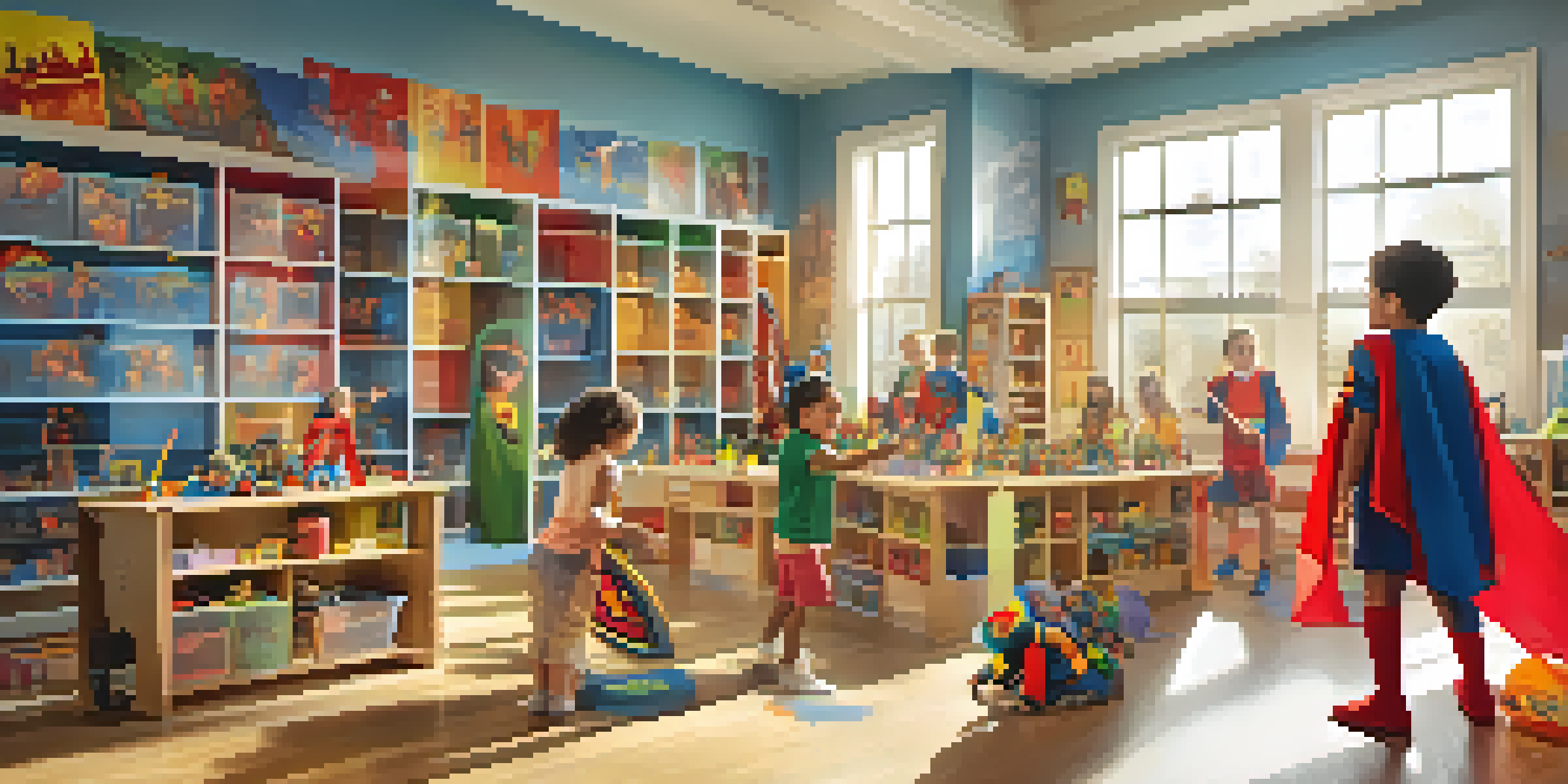The Role of Play in Language Acquisition for Young Learners

Understanding Language Acquisition in Young Learners
Language acquisition in young children is a natural process where they learn to communicate through listening, speaking, and interaction. This fundamental skill is developed primarily during early childhood, as children absorb language from their environment. The first few years of life are crucial, as children are particularly receptive to new sounds, words, and grammatical structures.
Play is the highest form of research.
During this stage, children are not merely passive listeners; they actively engage with language through play, conversations, and storytelling. This engagement helps them make connections between words and their meanings, which is essential for language development. The more children play and interact, the more language they acquire, paving the way for future communication skills.
Play is not just fun; it’s a vital learning tool that allows children to experiment with language in a low-pressure environment. Through role-playing, children mimic conversations they observe, testing out new vocabulary and sentence structures in a safe space. This exploration fosters confidence and encourages them to use language creatively.
The Connection Between Play and Language Development
Play provides a unique context for language development as it involves interaction, imagination, and problem-solving. When children engage in play, they often narrate their actions, negotiate roles, and express their thoughts, all of which require the use of language. This conversational practice is crucial for reinforcing vocabulary and improving sentence structure.

Moreover, through different types of play—like pretend play or cooperative games—children learn to use language in various social contexts. They practice taking turns, following rules, and expressing feelings, which are all integral components of effective communication. This kind of language use helps solidify their understanding of context and tone.
Play Enhances Language Skills
Engaging in play allows children to practice and expand their language skills in a fun, low-pressure environment.
Additionally, play often involves repetition, which is vital for language retention. When children reenact stories or play games that require verbal interaction, they solidify their grasp of words and phrases. This repetition, combined with the joy of play, makes learning feel effortless and enjoyable.
Types of Play That Enhance Language Skills
There are several types of play that can significantly boost language acquisition in children. For instance, dramatic play, such as playing house or pretending to be superheroes, allows for rich storytelling and vocabulary expansion. Children often create scenarios that require them to communicate effectively, enhancing their language skills in the process.
Children learn as they play. Most importantly, in play, children learn how to learn.
Another effective type of play is social play, which involves interaction with peers. Games that require teamwork or communication, such as charades or board games, encourage children to articulate their ideas and listen to others. Through these interactions, they learn to negotiate meaning and collaborate, which are key components of effective language use.
Lastly, constructive play—like building with blocks or crafting—can also foster language development. As children describe their creations or explain their building process, they practice using descriptive language and expanding their vocabulary. This hands-on play allows for meaningful language use tied to their interests.
The Role of Adults in Facilitating Play and Language Learning
Adults play a crucial role in facilitating play that enhances language acquisition. By providing engaging and diverse materials, such as books, toys, and games, caregivers can create an environment rich in opportunities for language use. It’s essential for adults to join in the play, guiding children with prompts and questions that encourage them to express themselves verbally.
Furthermore, adults can model language use through their interactions during play. This modeling is especially beneficial as children learn by observing and imitating the language used by adults. When adults narrate their actions or describe emotions while playing, it provides children with examples of how to use language effectively in different contexts.
Adults Facilitate Language Learning
Caregivers play a key role by providing resources and modeling language use during play to encourage verbal expression.
Encouraging open-ended play is also vital, as it allows children to explore language without restrictions. Adults should refrain from directing the play too much, as this can stifle a child’s creativity and language exploration. Instead, they should ask questions that prompt children to think and respond, fostering a rich dialogue.
Creating a Language-Rich Environment Through Play
To maximize language acquisition through play, it's essential to create an environment that is rich in language exposure. This can include having books accessible, labeling objects around the house, and incorporating songs and rhymes into daily routines. The more language children hear and interact with, the more opportunities they have to practice and develop their skills.
Incorporating a variety of play materials that stimulate conversation is also crucial. For example, puppet shows, storytelling sessions, and interactive games can encourage children to use language in fun and engaging ways. These activities not only enhance vocabulary but also develop comprehension and narrative skills.
Additionally, fostering a routine that includes play as a regular part of learning can significantly enhance language skills. Whether through structured playdates, family game nights, or solo imaginative play, consistent opportunities for children to engage with language will lead to more significant language development over time.
Challenges and Solutions in Using Play for Language Learning
While play is a powerful tool for language acquisition, there can be challenges in implementing it effectively. For instance, some children may be shy or reluctant to engage in verbal communication during play. In such cases, it's important for adults to create a supportive atmosphere that encourages participation without pressure.
Another challenge is the potential distraction that comes with play. Children can become so engrossed in activities that language learning takes a backseat. To counter this, adults can incorporate language goals into playtime, such as encouraging children to narrate their actions or describe their feelings as they play.
Long-Term Benefits of Play
Play-based learning fosters essential communication skills that contribute to academic success and personal fulfillment throughout life.
Additionally, it can be tempting to oversimplify language during play, but this can hinder a child's development. Instead, adults should aim to introduce new vocabulary and complex sentences in a way that is accessible yet challenging. This balance allows children to learn and grow their language skills while still enjoying the playful environment.
The Long-Term Benefits of Play for Language Skills
The benefits of incorporating play into language acquisition extend far beyond early childhood. Children who engage in play-based learning often develop stronger communication skills, which are crucial for academic success and social interactions later in life. As they grow, these foundational skills translate into better reading and writing abilities, enhancing overall literacy.
Moreover, play fosters critical thinking and creativity, which are essential in today’s fast-paced world. Children learn to express their ideas clearly and think independently, skills that will serve them well throughout their education and careers. The ability to communicate effectively is correlated with success in many aspects of life.

Ultimately, the joyful and engaging nature of play makes language learning a positive experience. When children associate language skills with fun and creativity, they are more likely to embrace learning throughout their lives. This lifelong love for language can lead to better relationships, enhanced learning, and personal fulfillment.